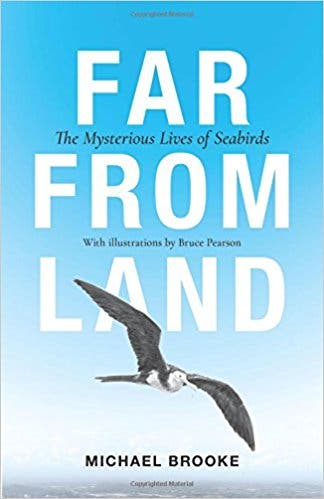A pair of gulls split up — from the frigid wasteland of Arctic Canada, one went to Peru, while the other went to South Africa, only to reunite once again next season in Canada. The sheer fact that we know this, that we can tell it with absolute certainty, is astonishing — and this is just one of the many amazing stories in Far From Land, The Mysterious Life of Seabirds.

Michael Brooke
Princeton University Press // 264 pp
Buy on Amazon
The freest of the free
Free as a bird — who hasn’t, at least once in their life, wanted to feel that way?
Few things are as romantic as seabirds. You see them on the shore, and then they’re gone, flying into the seemingly endless oceans. Where do they go? Why do they brace the frigid, merciless waters? Up until a few decades ago, we didn’t know much about the time these amazing creatures spend away from land, but modern science has answered many tantalizing questions about seabirds. In a very approachable and often dazzling book, Michael Brooke blends the seemingly incompatible worlds of romance and science
The book almost reads like a collection of fairy tales, stories from lands far away of almost-mythical creatures: the arctic tern (Sterna paradisaea), that fly about 40,000 kilometers (or 24,000 miles) each year, the albatrosses (Diomedeidae) which are able to circumnavigate the globe in 46 days and expend incredibly little energy in the process, and the adorable puffins (Fratercula), which nest away from the mainland to avoid predators. But these stories are very much real, and it wasn’t easy to figure them out.
Researchers have spent decades trying to understand the mysterious ways of seabirds, and they’ve done so mostly by tracking them. Birds, however, tend to be light, and weighing them down with heavy instruments is out of the question. For a while, biologists could only trace the largest of seabirds but thankfully, technology has gotten a lot better — and a lot lighter. This allowed researchers to gather information that might have once seemed unattainable, and even today is very impressive.
Far From Land reads very easily. You don’t need to be a specialist to appreciate it, you don’t really need to know anything about biology. However, it’s not like the topics presented in the book are simple. Michael Brooke writes with all the expertise and knowledge of a seasoned biologist, and it’s his own understanding and writing skill that makes the book so easy and pleasant to read. Furthermore, there is a detailed bibliography for every chapter, so if you are interested in learning more about seabird science, Far From Land is an excellent starting point.
All in all, Far From Land is an excellent read and requires no commitment — you can read it all in one go, or leave it by your bed and read it bit by bit. I couldn’t recommend it more, for everyone.


